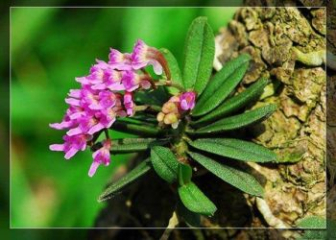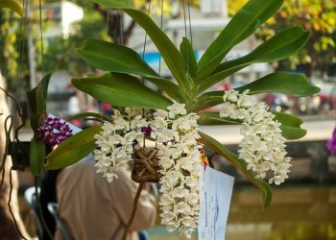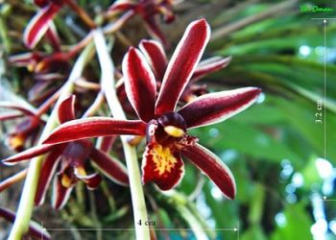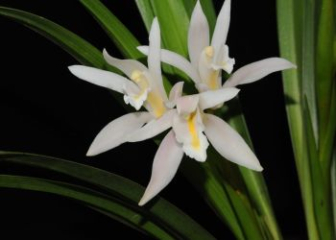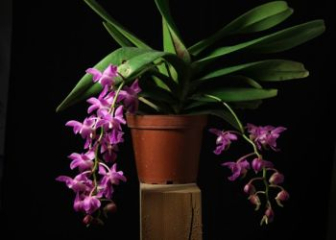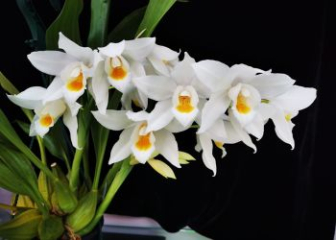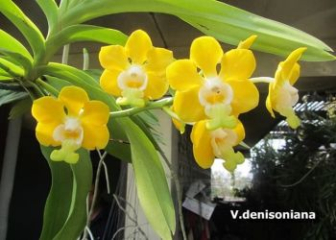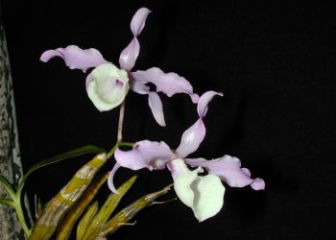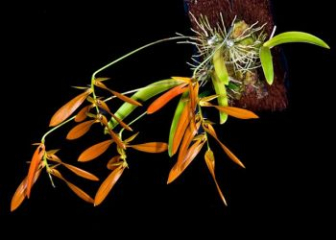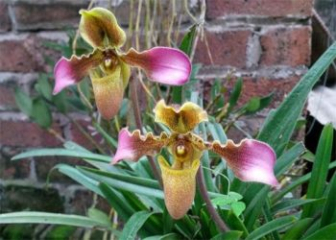Vanda Orchid - Detailed planting & care instructions from A to Z
Blog | by
Vanda orchid is one of the most popular orchid genus today, with large, beautiful flowers and colorful colors, commonly known as Vanda tricolor, Vanda coerulea, purple Vanda, yellow Vanda,...
Vanda orchids are one of the most famous and popular orchid genera today, loved for their unique beauty, diverse colors, large flowers, colorful colors and year-round flowering.
From rare purebred lines to super easy-to-grow hybrid lines, each Vanda orchid species brings growers extremely interesting experiences and irresistible beauty.
In today's article, let's learn in detail about the origin, characteristics, classification and basic care techniques of Vanda orchids so that you can gain more experience before trying this orchid genus.
Origin of Vanda orchid
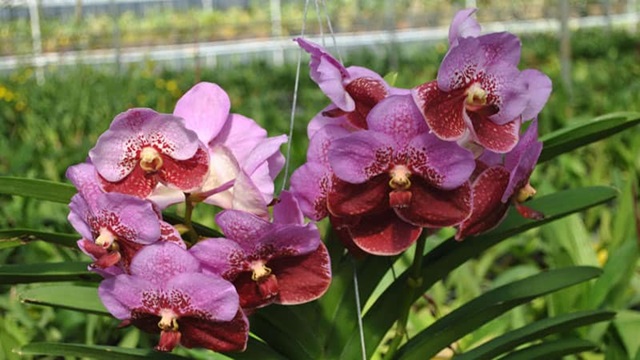
Vanda orchids are a genus of orchids common in Asia.
Vanda orchid is a tropical orchid genus with more than 80 different species, distributed mainly in Asia, especially in some areas such as: India, China, Vietnam, Thailand, Australia,...
In Vietnam alone, Vanda orchids are widely distributed in provinces from North to South, especially in the Central and Central Highlands provinces.
The genus Vanda includes epiphytic or lithophytic (rock-living) orchids that thrive in moist tropical forests with strong diffuse light, high humidity, and good ventilation.
Nowadays, Vanda orchids are crossbred with many other genera to create new Vanda varieties with more colorful, beautiful flowers that are easier to grow.
The name “Vanda” is derived from the ancient Sanskrit word “वन्द” which means precious and beautiful orchids.
General characteristics of Vanda orchids
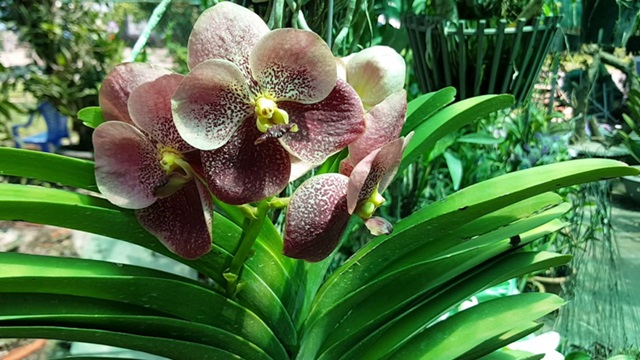
Vanda orchids have large flowers, single stems, and grow upright.
Although there are many species of orchids, in general, the Vanda orchid genus still has many common characteristics in morphology and growth, specifically as follows:
Trunk :
- Single stem, upright, unbranched.
- Stem height from 30cm - 1.5m depending on species
- The stem has many segments, each segment grows a new pair of leaves and roots.
Leaves :
- Vanda orchid leaves grow symmetrically, long, thick and sturdy
- There are three common leaf shapes including round leaves, semi-round leaves and flat leaves.
Roots :
- Roots develop strongly, mainly aerial roots, good adhesion ability
- The roots are silvery white or greenish, covered with a thin layer of velvet.
- The roots of Vanda orchids often have the ability to breathe and photosynthesize slightly, so they can still survive well without a substrate for a short time.
Flower :
- Flowers grow in clusters from leaf axils.
- Vanda orchid flowers are usually large, averaging 5 - 10 cm.
- Colorful and diverse colors such as purple, blue, yellow, red, white, pink, polka dot, spotted, striped Vanda orchids,...
- Thick, shiny petals, long lasting flowers
- Many Vanda lines have pleasant aromas such as Vanda Denisoniana, Vanda tricolor,...
Adaptability :
- Is a genus that loves strong light.
- Temperature from 25 - 35 degrees Celsius, humidity 60 - 80%
- Can be grown in pots, grafted on wood or planted bare root without substrate
Genetic ability :
- Has strong, stable genetics
- There are now thousands of hybrid Vanda varieties with different colors.
Popular Vanda Orchid Species
There are thousands of different species of Vanda orchids, including natural and hybrid lines. Below are some of the most popular lines, let's learn more.
Vanda hybrid is popular in Vietnam
In Vietnam today, hybrid Vanda orchids are very popular because they are easy to grow, easy to care for and have beautiful, long-lasting flowers. Some typical lines are as follows:
- Vanda Kultana Gold: Flowers are orange-yellow, durable, and colorful.
- Dark purple Vanda orchid (Vanda Pachara Delight): Flowers are dark purple, glossy petals with clear veins.
- Red-purple Vanda Orchid (Vanda Robert's Delight): Flowers are red-purple, round, and last a long time.
- Vanda Bangkok Blue: Flowers are blue-purple, very large, thick petals
- Brown-pink Vanda orchid (Vanda Mimi Palmer): Flowers are pink-brown, fragrant, and unique.
Vanda Miss Joaquim

Singapore Vanda orchid with sweet pink color.
Vanda Miss Joaquim, also known as Vanda Singapore, is the world's first hybrid orchid bred in 1893 between Vanda teres x Vanda hookeriana, and this Vanda species became the national flower of Singapore in 1981.
Characteristics of Vanda Miss Joaquim orchid:
- The flower has a purple-pink color, orange-yellow lips, and twisted petals that look very elegant.
- Average flower size from 5 - 6 cm
- Flowers last about 3 weeks, no scent
- Is a light-loving species.
Vanda denisoniana
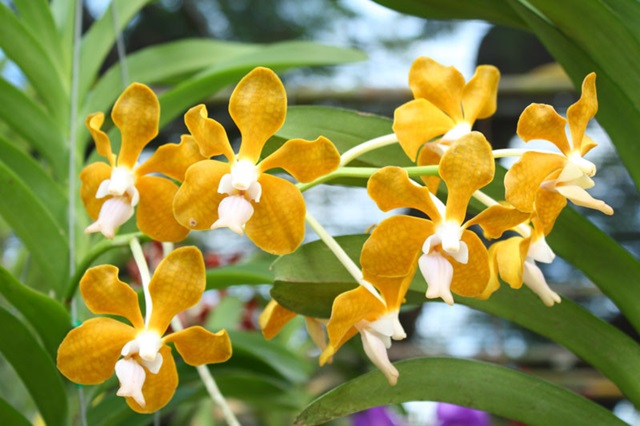
Vanda denisoniana orchids with bright orange flowers.
Vanda denisoniana, also known as yellow Vanda, golden Vanda, originates from Southeast Asia, especially popular in Vietnam, Thailand, Laos,... thanks to its good adaptability and beautiful, colorful flowers.
Characteristics of yellow Vanda orchid:
- Flowers are lemon yellow or orange yellow
- Flowers are 5 - 7 cm in size, with round, slightly shiny petals, growing in clusters of 5 - 10 flowers.
- The flowers are very fragrant, slightly sweet and pleasant smell.
- Flowers usually bloom in spring - early summer, lasting about 2 - 3 weeks.
Vanda tricolor
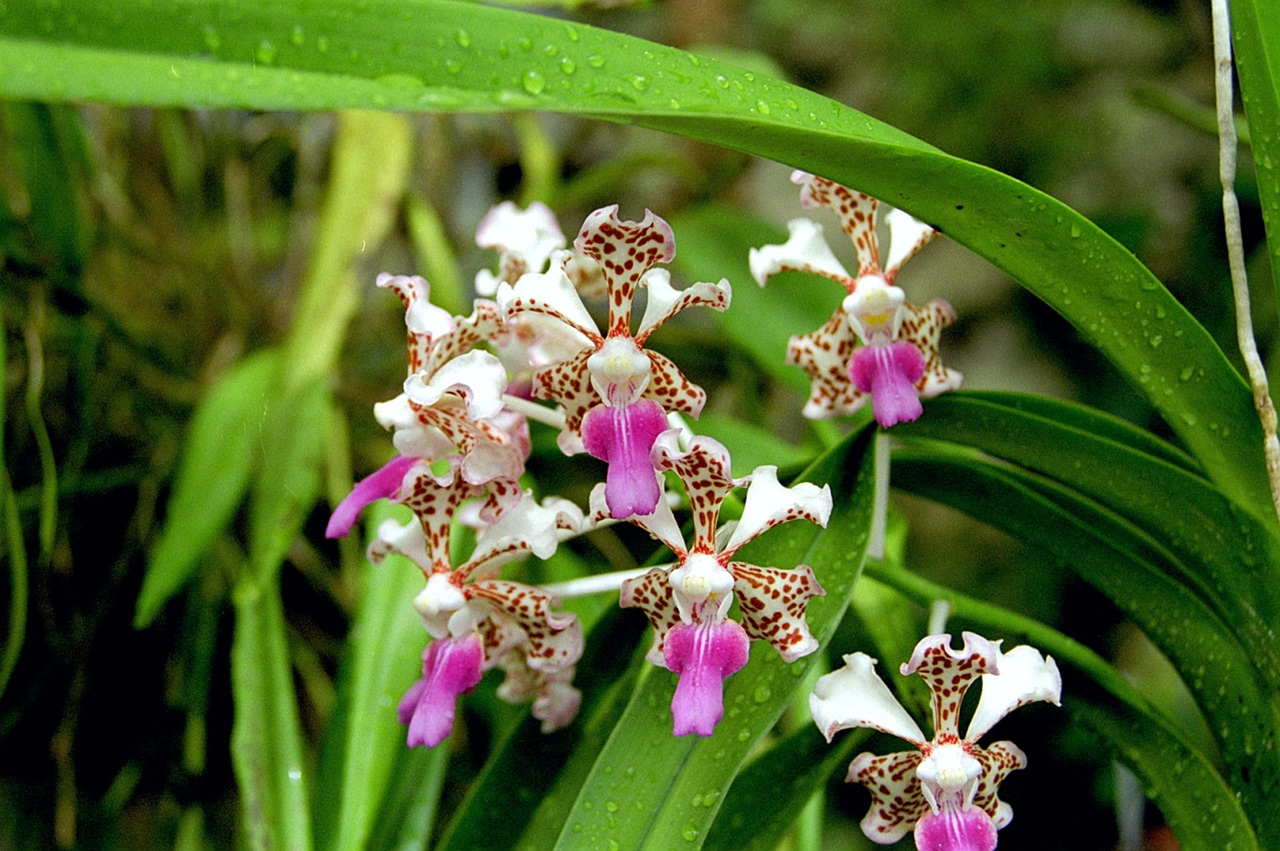
A bunch of 3-color Vanda orchids with a unique appearance.
Vanda tricolor, also known as Vanda three colors, is one of the most beautiful and favorite original Vanda orchid lines. It originates naturally in Indonesia, Myanmar, Laos and Vietnam.
Characteristics of 3-color Vanda orchid:
- The flowers are cream-white in color, combined with brown, purple and pink-purple spots on the lip of the flower, creating a unique, eye-catching combination.
- Flowers are 5 - 7cm in size, blooming in clusters of 4 - 10 flowers.
- Has a sweet, very distinctive scent
- Flowers usually bloom in the dry season - spring (from December to March).
Vanda coerulea

Vanda coerulea orchid flowers are blue-purple with netted veins.
Vanda coerulea is one of the few natural orchid species with a unique purple-blue color that is considered rare. It originates naturally in India, Bhutan, Myanmar, Thailand,... They are also known by many other names such as blue Vanda orchid, Blue Vanda, Vanda lam,...
General characteristics of Vanda lam:
- The flowers are blue-purple in color, with characteristic dark net veins.
- Flowers are 6 - 10 cm in size, growing in clusters of 5 - 15 flowers.
- Large, thick, slightly twisted petals
- Flowers have a light, pleasant fragrance
- Flowers last a long time, 3 - 4 months, usually blooming from late autumn to early winter (September - December)
Basic Vanda orchid planting & care techniques
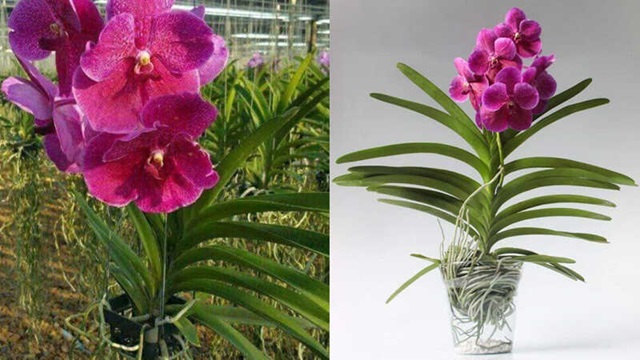
Basic Vanda orchid growing techniques.
If you are new to growing Vanda orchids and don't know where to start, here are some basic techniques to follow.
Choose the right Vanda orchid variety
As you know, there are many different Vanda orchid lines. Therefore, you need to choose carefully to find the species that is suitable for the climate in our country and easy to care for. Typically, some of the following species:
- Vanda coerulea (Vanda lam): Cool-loving Vanda variety.
- Vanda tricolor, denisoniana, Miss Joaquim: Can withstand sunlight well, suitable for the climate in Vietnam.
Prioritize choosing seedlings with green, hard leaves, not crushed, free of pests, strong, plump roots with silvery white color, green root tips.
Choose the right pot & substrate
You can grow Vanda orchids in grafted or hanging pots, and here are some basic requirements for pots and substrates:
- Pot : Choose a terracotta pot, plastic pot, basket or driftwood with good drainage.
- Substrate : Pine bark, charcoal, coir, Chilean coir. If the environment is airy, it can be grown without substrate.
How to grow/graft Vanda orchids
To grow Vanda orchids properly, helping the plant take root quickly and grow optimally, please follow the instructions below.
How to plant Vanda orchids in pots :
- Soak orchid roots in Physan 20 or lime water for 15 - 20 minutes to disinfect.
- Line a layer of substrate at the bottom of the pot.
- Place the Vanda orchid straight in the middle, no need to cover the base
- Use a tie or stick to keep the orchid in place.
- Hang the pot in a cool place with soft light.
- Stop watering for the first 2-3 days, then spray lightly and gradually increase watering frequency.
How to grow hanging Vanda orchids (bare roots) :
- Use a rope to tie lightly to the main stem, hang the tree so that the roots can develop freely.
- Hang the tree in a place with strong diffused light, away from rain.
- Water a lot in the early morning, if the weather is too dry, water more in the cool afternoon.
- Combine with liquid fertilizer sprayed on roots and stems once a week.
How to graft Vanda orchids onto wood/coir :
- Place the orchid roots on the wooden surface
- Use soft wire to fix the orchid stem to the board, do not tighten it.
- Hang the orchid in a cool place, water lightly for the first week, then water and care as usual.
How to stimulate roots for Vanda orchids :
- Method 1: Use diluted B1 + Atonik or B1 + Root to soak or spray on the base and trunk about 2 times/week, and hang in a cool place with gentle light.
- Method 2: Use root stimulants such as Super Thrive, Rooting Hormone
How to care for Vanda orchids
To help Vanda orchids grow well, you should pay attention to light, watering, fertilizing and disease prevention. Please note some of the following basics.
Temperature & Light:
- Maintain diffused light around 70%, should not be placed in complete shade
- Temperature from 25 - 32 degrees Celsius
- Humidity from 60 - 80%
- Ventilated environment, high hanging
Watering properly :
- Sunny season: Water twice a day in the early morning and cool afternoon.
- Rainy season: Only water when the growing medium is dry.
- Cold season: Reduce watering, prioritize misting
- Note: Mainly water the roots, do not let water accumulate between leaves, do not water at night.
Fertilize at the right stage :
- Plant care stage: NPK 20-20-20 fertilizer
- Flowering stage: NPK 10-30-20, 6-30-30
- Flowering stage: NPK 15-15-30 combined with micronutrients.
- Note: Spray fertilizer on leaves, stems and aerial roots, do not spray directly on orchid roots, use diluted fertilizer at a ratio of 1g/1 liter of water.
Basic disease prevention and treatment :
- Vanda orchids have rotten tips: Cut off the rotten part, apply lime or healing glue, and limit watering the tips.
- Vanda orchids have root rot: Cut off damaged, rotten roots, use Physan to disinfect
- Vanda orchids have leaf fungus: Spray Antracol, Ridomil,...
Vanda orchid price list
Currently, depending on each species of Vanda orchid, they will be sold at different prices, from a few hundred to a few million VND. You can refer to the selling prices of some popular Vanda varieties below.
|
Vanda orchid |
Reference price |
|
Vanda Miss Joaquim (Lan Vanda Singapore) |
100,000 - 800,000 VND/pot, depending on small pot or mature pot with flowers |
|
Vanda denisoniana |
150,000 - 1,200,000 VND/pot |
|
Vanda tricolor |
200,000 - 1,500,000 VND/pot |
|
Vanda coerulea (Vanda lam) |
300,000 - 4,000,000 VND/pot |
|
Vanda hybrid (multi-color) |
80,000 - 700,000 VND/pot |
Vanda orchid image
We invite you to admire the series of Vanda orchid photos that we share below to fully appreciate the richness of shape and color of this famous orchid genus. We guarantee that you will be amazed by the beauty that these Vanda lines bring.
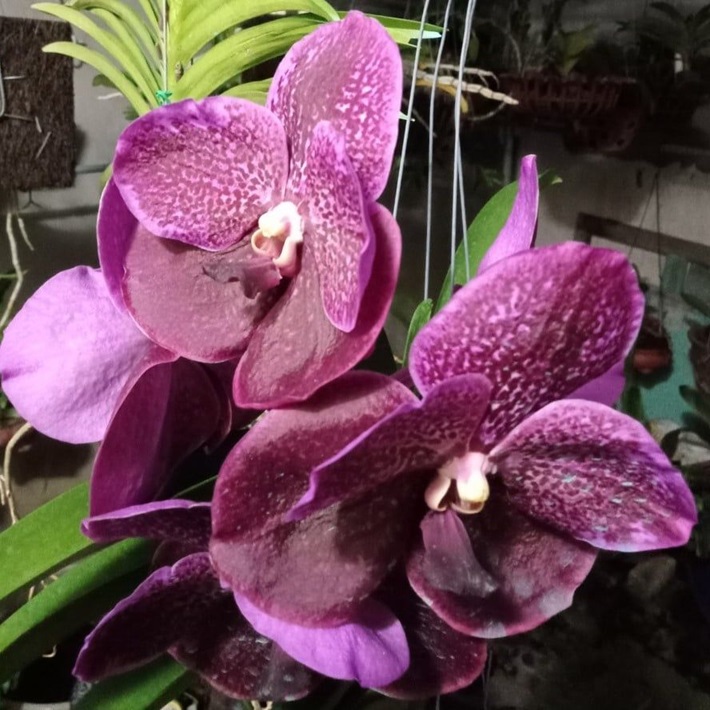
Purple Vanda Orchid - Vanda Robert's Delight with impressive color tones.
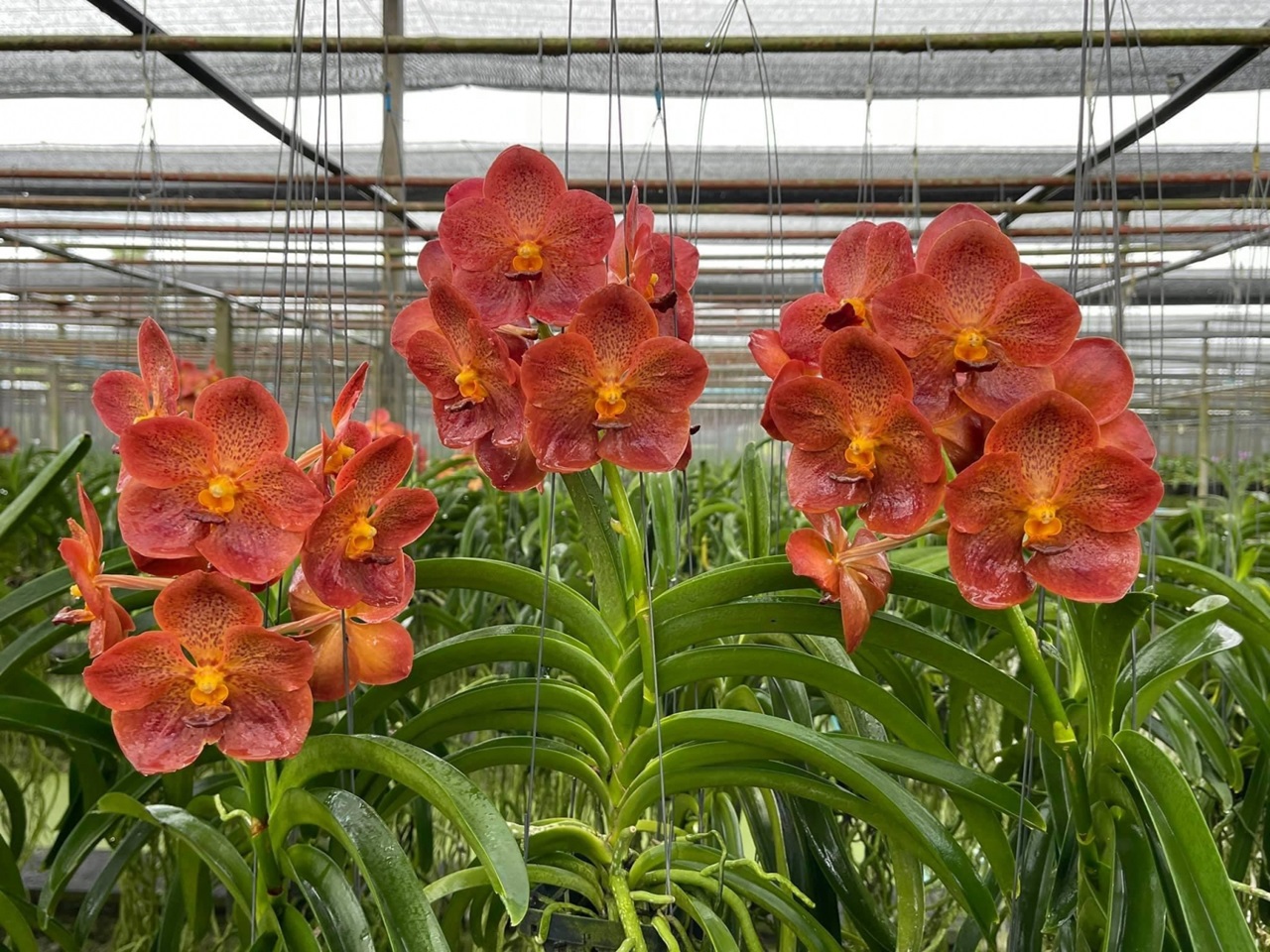
Red Vanda orchid with colorful, outstanding colors.
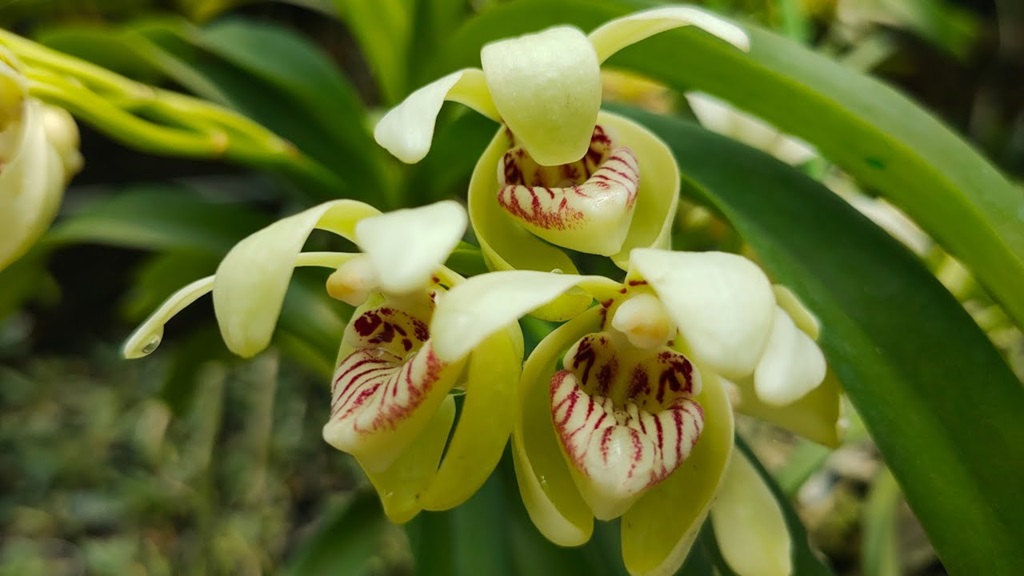
Vanda orchids with unique patterns.
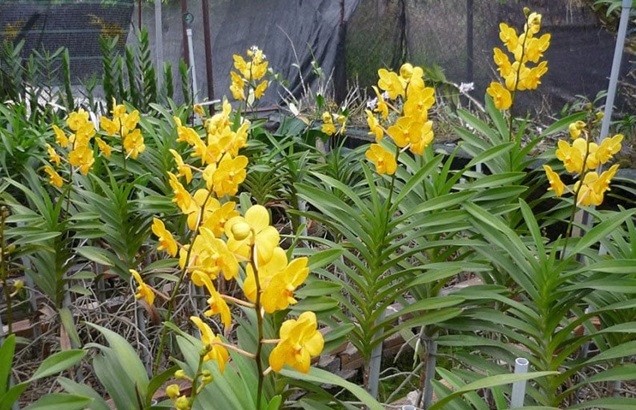
Vanda orchids with prominent yellow flowers.
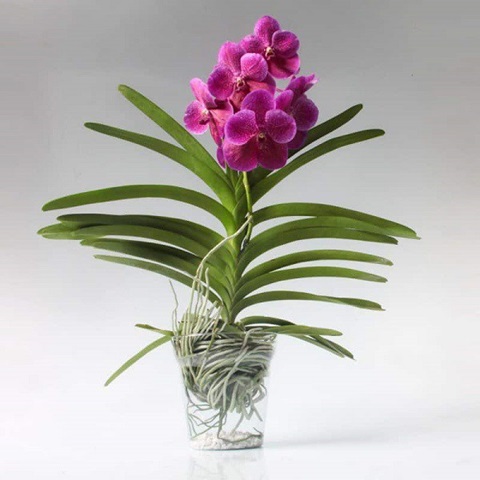
A small pot of beautiful Vanda orchids.
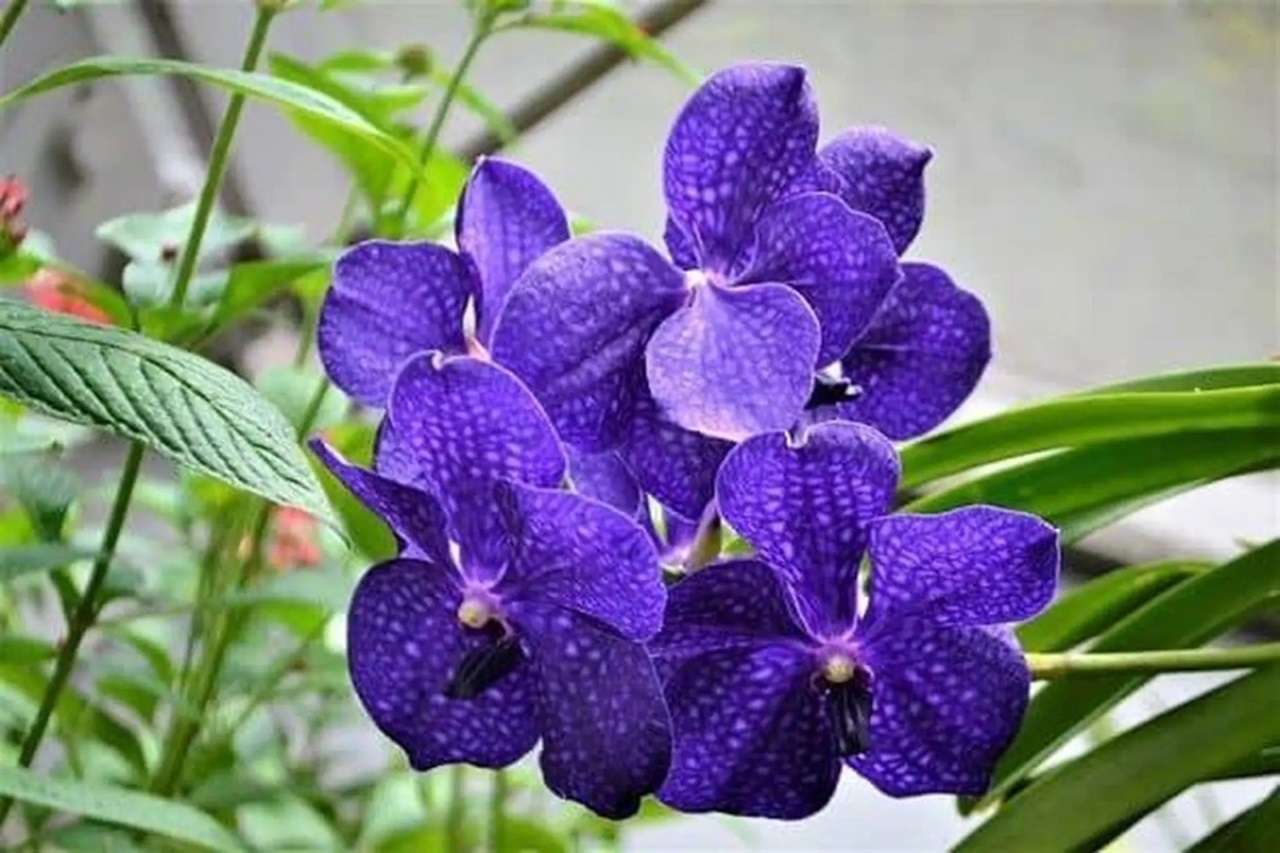
Blue-violet Vanda orchids are rare and valuable.
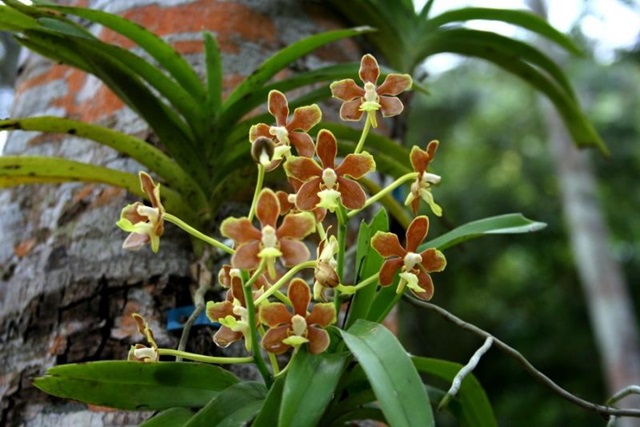
Lovely small brown Vanda orchid cluster.
Thus, through the article that hoalanrung.net shares above, it can be seen that Vanda orchids are indeed one of the most famous orchids today. Not only possessing a unique beauty with large, colorful flowers, but also very easy to grow, easy to adapt, suitable for many climatic conditions.
If you want your orchid garden to be more brilliant, don't miss the orchids in the Vanda genus. You will definitely get very satisfactory results.
Don't forget to read the next articles in our Blog section to learn more about many other orchid species.
